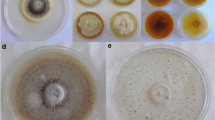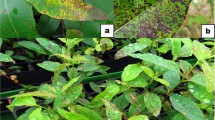Abstract
Stemphylium vesicarium (teleomorph: Pleospora herbarum) is the causal agent of brown spot disease in pear. The species is also able to cause disease in asparagus, onion and other crops. Saprophytic growth of the fungus on plant debris is common. The objective of this study was to investigate whether isolates of S. vesicarium from different hosts can be pathogenic to pear. More than hundred isolates of Stemphylium spp. were obtained from infected pear fruits, dead pear leaves, dead grass leaves present in pear orchard lawns as well as from necrotic leaf parts of asparagus and onion. Only isolates originating from pear orchards, including isolates from dead grass leaves, were pathogenic on pear leaves or fruits in bioassays. Non-pathogenic isolates were also present in pear orchards. Stemphylium vesicarium from asparagus or onion, with one exception, were not pathogenic to pear. Analysis of the genetic variation between isolates using Amplified Fragment Length Polymorphism (AFLP) showed significant concordance with host plants. Isolates from asparagus or onion belonged to clusters separate from the cluster with isolates from pear or grass leaves collected in pear orchards. Multilocus sequencing of a subset of isolates showed that such isolates were similar to S. vesicarium.



Similar content being viewed by others
References
Aveling, T. A. S., & Snyman, H. G. (1993). Infection studies of Stemphylium vesicarium on onion leaves. Mycological Research, 97, 984–988.
Câmara, M. P. S., O’Neill, N. R., & van Berkum, P. (2002). Phylogeny of Stemphylium spp. based on ITS and glyceraldehyde-3-phosphate dehydrogenase gene sequences. Mycologia, 94, 660–672.
Carbone, I., & Kohn, L. M. (1999). A method for designing primer sets for speciation studies in filamentous ascomycetes. Mycologia, 91, 553–556.
Chaisrisook, C., Stuteville, D. L., & Skinner, D. Z. (1995). Five Stemphylium spp. pathogenic to alfalfa: occurrence in the United States and time requirements for ascospore production. Plant Disease, 79, 369–372.
Cowling, W. A., Gilchrist, D. G., & Graham, J. H. (1981). Biotypes of Stemphylium botryosum on alfalfa in North America. Phytopathology, 71, 679–684.
Falloon, P. G., Falloon, L. M., & Grogan, R. G. (1987). Etiology and epidemiology of Stemphylium leaf spot and purple spot of asparagus in California. Phytopathology, 77, 407–413.
Gerrits van den Ende, A. H. G., & de Hoog, G. S. (1999). Variability and molecular diagnostics of the neurotropic species Cladophialophora bantiana. Studies in Mycology, 43, 151–162.
Irwin, J. A. G., Dill-Macky, R., & Stirling, M. (1986). Taxonomic studies on Australian isolates of Stemphylium spp. and associated teleomorphs. Australian Journal of Botany, 34, 281–292.
Hudson, H. J. (1971). The development of the saprophytic fungal flora as leaves senesce and fall. In T. F. Preece, & C. H. Dickinson (Eds.), Ecology of leaf surface micro-organisms (pp. 447–455). London: Academic.
Koike, S. T., Henderson, D. M., & Butler, E. E. (2001). Leaf spot disease of spinach in California caused by Stemphylium botryosum. Plant Disease, 85, 126–130.
Leuprecht, B. (1990). Stemphylium botryosum Wallr. on asparagus. Gesunde Pflanzen, 42, 187–191.
Llorente, I., & Montesinos, E. (2006). Brown spot of pear: an emerging disease of economic importance in Europe. Plant Disease, 90, 1368–1375.
Llorente, I., Vilardell, A., & Monesinos, E. (2006). Infection potential of Pleospora allii and evaluation of methods for reduction of the overwintering inoculum of brown spot of pear. Plant Disease, 90, 1511–1516.
MacHardy, W. E., Gadoury, D. M., & Gessler, C. (2001). Parasitic and biological fitness of Venturia inaequalis: relationship to disease management strategies. Plant Disease, 85, 1036–1051.
Pattori, E., Rossi, V., Bugiani, R., & Giosuè, S. (2006). Virulence of Stemphylium vesicarium isolates from pear and other host species. IOBC/wprs Bulletin, 29(1), 195–205.
Polfliet, M. (2002). Aantasting Stemphylium neemt met het jaar toe [Infection of Stemphylium increases every year]. Fruitteelt, 92(20), 16–17.
Ponti, I., Cavanni, P., & Brunelli, A. (1982). Maculatura bruna delle pere: eziologia e difesa. Informatore Fitopatologico, 32, 35–40.
Prados-Ligero, A. M., González-Andújar, J. L., Melero-Vara, J. M., & Basallote-Ureba, M. J. (1998). Development of Pleospora allii on garlic debris infected by Stemphylium vesicarium. European Journal of Plant Protection, 104, 861–870.
Pryor, B. M., Davis, R. M., & Gilbertson, R. L. (1994). Detection and eradication of Alternaria radicina on carrot seed. Plant Disease, 78, 452–456.
Rossi, V., Bugiani, R., Giosué, S., & Natali, P. (2005a). Patterns of airborne conidia of Stemphylium vesicarium, the causal agent of brown spot disease of pears, in relation to weather conditions. Aerobiologica, 21, 203–216.
Rossi, V., Pattori, E., Giosué, S., & Bugiani, R. (2005b). Growth and sporulation of Stemphylium vesicarium, the causal agent of brown spot of pear, on herb plants of orchard lawns. European Journal of Plant Pathology, 111, 361–370.
Rossi, V., Pattori, E., & Bugiani, R. (2008). Sources and seasonal dynamics of inoculum for brown spot disease of pear. European Journal of Plant Pathology, 121, 147–159.
Simmons, E. G. (1967). Typification of Alternaria, Stemphylium, and Ulocladium. Mycologia, 59, 67–92.
Simmons, E. G. (1969). Perfect states of Stemphylium. Mycologia, 61, 1–26.
Simmons, E. G. (1985). Perfect states of Stemphylium. II. Sydowia, 38, 284–293.
Singh, P., Bugiani, R., Cavanni, P., Nakajima, H., Kodama, M., Otani, H., et al. (1999). Purification and biological characterization of host-specific SV-toxins from Stemphylium vesicarium causing brown spot of European pear. Phytopathology, 89, 947–953.
Thomma, B. P. H. J. (2003). Alternaria spp.: from general saprophyte to specific parasite. Molecular Plant Pathology, 4, 225–236.
Vos, P., Hogers, R., Bleeker, M., Reijans, M., van de Lee, T., Hornes, M., et al. (1995). AFLP: a new technique for DNA fingerprinting. Nucleic Acids Research, 23, 4407–4414.
White, T. J., Bruns, T., Lee, S., & Taylor, J. (1990). Amplification and direct sequencing of fungal ribosomal RNA genes for phylogenetics. In M. S. Innis, D. H. Gelfand, J. S. Sninsky, & T. J. White (Eds.),PCR protocols: A guide to methods and applications (pp. 315–322). New York: Academic.
Acknowledgements
We acknowledge the support by P.-F. de Jong, Applied Plant Research, J. van Mourik, Centrale adviesdienst voor de Fruitteelt B.V. (CAF) and P.A.W.M. Aalbers, Fruit Consultancy (DLV) for providing samples of pears; M. Plentinger, Applied Plant Research, and J.M.B. Meulendijk DLV Plant (Akkerbouw) for providing samples of asparagus and P. Creemers, Gorsem, Belgium, for providing several cultures of Stemphylium spp.
Author information
Authors and Affiliations
Corresponding author
Rights and permissions
About this article
Cite this article
Köhl, J., Groenenboom-de Haas, B., Goossen-van de Geijn, H. et al. Pathogenicity of Stemphylium vesicarium from different hosts causing brown spot in pear. Eur J Plant Pathol 124, 151–162 (2009). https://doi.org/10.1007/s10658-008-9402-2
Received:
Accepted:
Published:
Issue Date:
DOI: https://doi.org/10.1007/s10658-008-9402-2




